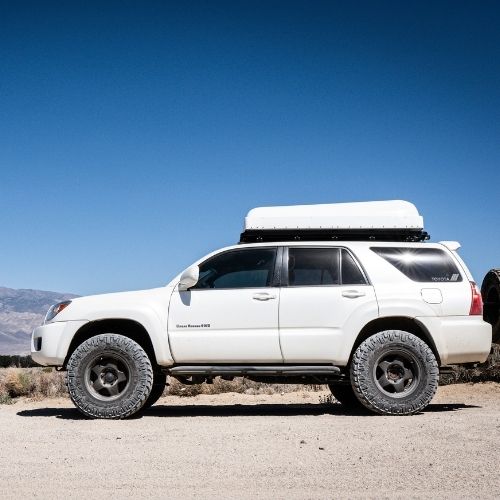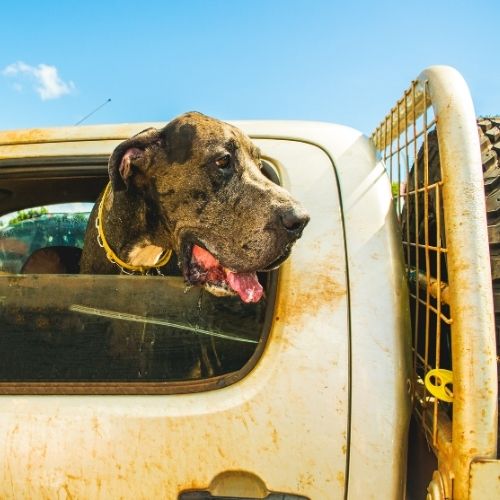We may get commissions for purchases made through links in this post. Thanks for the support! 👍
If you are a seasoned adventurer looking for a new car to take overlanding, you will likely want to choose something with 4WD. A 4×4 will give you the best chance of handling all of the different terrains and underdeveloped roads that may be part of your journey.
But what if you already have a 2WD vehicle and want to start Overlanding? Having a 4×4 will, of course, give you an advantage, but that doesn’t mean 2WD vehicles can’t join in the fun. It will simply take a little more preparation and caution to ensure that the car can make it out of any compromising situations.
Here we will look at some things that you will want to know when overlanding in a 2-wheel drive vehicle.
1. Stay away from mud and other large obstacles
Going overlanding can be a ton of fun in a truck or SUV, however 2WD is going to keep you away from the more intense obstacles such as mud, large ruts, bolders, and other hard to traverse things.
When you only have 2WD, that means only your rear two wheels will be turning with power, making it impossible to move if those tires become stuck or lose traction. 4WD would fix this normally, however without that equipped it becomes more difficult.
If you run into something that you know you can’t get through without 4WD you will need to find another way around, or have someone around to help you if you do get stuck.
2. Overland on roads, trails and dirt
A great way to stay away from the obstacles we talked about above, make sure to plan ahead so that you are on well travelled areas like roads, trails and dirt (not mud).
The great thing about Overlanding, is that it is different for everyone, and a 2WD truck will just mean you probably will spend more time on the road going faster than going slower over rocks.
Both are a ton of fun, but just a different experience.

3. Attach a winch to your truck
The biggest thing you will run into when off-roading your 2WD truck, is getting stuck, so why not attach a winch to your truck?
Winches can act as a way to get around not having 4WD, as you can attach them to trees, bushes, or other items in the area you are stuck to get you, well, unstuck.
You mainly want to make sure you are getting a winch that has the capacity, and reliability that you need while out in the woods. This one right here seems like an awesome option for yah.
4. Lift the truck
If all you have is the rear two tires moving your truck along, you need to find other ways to make sure you don’t get stuck.
One of the best ways to do this, is to add clearance to your truck in the way of a lift kit.
Lift kits can range heavily in height and quality, so make sure to do all of your research before buying one for yourself.
These kits will allow you to have more clearance in the front, rear, and sides of the vehicle, meaning you won’t high center, and lose traction on the 2 wheels that you currently have power to.
5. Make sure to have good Tires
The first thing you can do to increase your chances of success while Overlanding in a 2WD car or truck is to check that your tires are in good working condition.
If you can invest in new, All-terrain tires, this is the best option. Well-loved tires with worn-down tread should be replaced if you plan to take your vehicle on any adventure.
Another option, is to get yourself some high quality off-road tires to help yourself out when you actually do go off-roading. Keep in mind though, off-road tires do take away from on-road performance, so make sure you take into account whether you will be overlanding more on the road, or off the road.

6. Tire Deflator & Air Compressor
Additionally, you will want to keep a tire deflator kit and an air compressor with you at all times. When driving in sand, mud, or soft dirt, releasing a small amount of air from your tires will increase your traction and help to prevent your tires from spinning and digging themselves deeper into the ground. This kit here should work perfectly for this.
Just be careful of sharp rocks, as the loss in pressure can increase puncture risk.
Once you are back on the pavement, you will need the air compressor to fill the tire back up to its recommend PSI. You can buy these at all different types of places, however this one would be a great value.
- TOP 8 Best Bull Bars For RAM 1500 [And Others]
- Ford Bronco vs Raptor: Which would I get?
- TOP 8 Best Truck Bed Organizers
7. Additional Equipment
You will also want to have plenty of other equipment on board to help you if you get stuck. This will include traction boards, a sturdy jack, ropes, straps, and a shovel.
These tools are essential if you plan to take your car off-road but can be helpful even when you may not expect it. As an Overlander, you will encounter bad weather, unmaintained roads, and less than ideal parking lots.
You never know when you may need to get un-stuck, and having this equipment will give your 2WD vehicle a fighting chance should the worst happen.
8. Never go alone
Finally, common sense is the most important tool to bring when Overlanding in a 2WD vehicle. If you are nervous at all about your car’s ability to handle some terrain, don’t go.
You can take a bit more risk if you are caravaning with another vehicle that has 4WD, but even still, exercise caution.
Also, try to avoid taking dangerous roads alone, and if you must travel solo, always let someone know where you are in case you get stuck and cannot get yourself out.
Conclusion
A 4×4 vehicle will always have a better chance off-road, but that shouldn’t stop you from getting out there and Overlanding in a car or truck with 2WD.
You can always choose safer roads, and being prepared with all of the resources listed above will help if you encounter some unexpectedly rough terrain.
Be cautious, be prepared, and you can absolutely use your 2WD vehicle to get out there and see the world.


